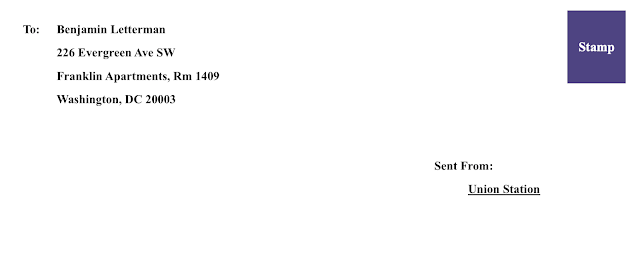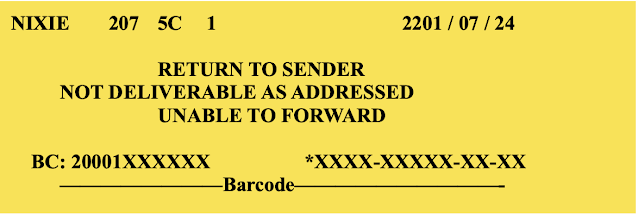*Originally published on another blog of mine, Miscellaneous Notes, now republished here with slight edits and modifications*
Two days ago I finally received in my mailbox the letter sent from Union Station nearly a month ago on Dec. 18. Turns out it was not lost in the system, or stolen in transit, but was deemed to have been a “Nixie,” or a piece of somehow “undeliverable mail”. But then of course you should ask as I do — If the letter was supposed to be delivered to myself, was marked clearly as intended for such delivery, and eventually got to me, how on earth was it “not deliverable”? Good question, as always, and one to which I can offer only the most hypothetical of answers.
What Does It Look Like?
Before we begin, it is necessary that I should tell you upfront what my mailpiece looks like and what information I have printed on the envelope, so that you could judge for yourself whether it conforms to the standards of deliverability. The envelope and its markings look something like the following:

At this stage you surely have noticed that two differences exist between my envelope and one sent by a normal person. The first is its lack of a return address (i.e. address of the sender). This is because, if I am to honestly put down the sender’s name and address, they would be identical to those of the recipient, which would look pretty silly. Of course an anonymous sender would be more suspicious than silly, but I made sure to disperse of any such suspicions by putting into the envelope a strip of paper concisely explaining how it was sent solely for recreation — the envelope itself is thin and flimsy enough that, should it fall into the hands of some postal inspector, they only need put the whole thing in front of a light source and read my short paragraph, before laughing it off as the harmless experiment that it is. Indeed, since I did receive several other of my sent envelopes in exactly the same format, one of which was mailed from a Congressional office building, I do not suppose an anonymous sender raises any alarm for the postal service.
The second difference is that I put the delivery address in the upper left corner, and not at the center like most people do. At first I suspected that, because machines are now used to read handwritten envelopes, an out-of-place placement of recipient’s address may confuse the machinery and require human confirmation, hence causing delay. The USPS, however, the proud (and worthy) “world leader in optical character recognition (OCR),” now has machines reading 98% of all hand-addressed letters, and is considerably good at it. I do not consider myself a terrible hand-writer, so it is unlikely that so many of my letters were to fall into the unlucky 2%.
Moreover, both of these problems would only have led to delays and not undeliverability — any suspicion, once dissipated, should not prevent the Postal Service from forwarding the letter, and an address unreadable to a mechanical eye can still be easily typed in manually, not to say delivered successfully by a human carrier. So, why was this letter a “nexie”?
The Nexie Label
This question became even more perplexing when I gave my envelope a second look.
First, the letter was cancelled — The stamp was (ungracefully) smudged by black marker ink (to prevent reuse, a common practice), and a Christmasy postmark was affixed next to it bearing the date of Dec. 18. Because the machines at USPS (such as the so-called Advanced Facer-Canceller) seem to read the address first before applying postmarks, it would appear that my address was successfully recorded before running into a problem.
But what kind of a problem? The envelope has a bright yellow sticker on it containing some curious information, which I will transcribe below:

Several points stand out from this yellow strip of paper. First, the zip code following “BC” (which stands for the barcode below, essentially a machine-readable transcription of the numeral code), when entered into any online zip code database, specifically identifies not only the apartment building, but the very floor I live on (the database actually says it belongs to the unit a few steps down the corridor), so the system definitely read and recognized my “To” address.
Second, the date on its top right, so far away in the future that its presence adds to my plain envelope a trace of mystique. Apparently it denotes the date when my letter was processed, so pretty decent of my time-traveling letter to have returned to me, I guess. Or alternatively there must have been some glitch with the machinery or software.
Third, the “207” part indicates the processing site location. In this case I believe it was at the Suburban MD Annex in Gaithersburg, Maryland. Not very helpful.
Two Possible Answers
In the end I have come to the conclusion that only one of those two things must have happened — Either there was a mess-up at the back-end, where somebody saw this envelope, confused the “to” address with the “from” address and thought the letter was meant for “Union Station”, in which case it would have been too vague to be forwarded — or there was a mess-up at the front-end, where the carrier read the “to” address, found it unfamiliar or thought it faulty, before returning it to USPS’ forwarding department for further research, before said department determined it is in fact a valid address, instructed the carrier so, and had them deliver it after a four-week ordeal.
I myself strongly favor the first hypothesis. The mail delivery lady for my area seems perfectly competent, and she has delivered some of my other letters (in identical envelopes) without issue. It is also plainly unimaginable how a human carrier could read a legible and correct address of a well-established apartment and in good faith find it undeliverable.
It is to say, the problem was within the processing center. It is not impossible that, by virtue of my apartment being a rental property, somewhere in the “nooks and crannies” off USPS’ database my unit is still paired with its former occupant, and so when my name instead of hers showed up the system detected some inconsistency and hence deemed it undeliverable. Perhaps after the label was added some other clerk double-checked it, shrugged at the database’s incompetence and returned my perfectly good letter to its proper carrier who eventually deposited it downstairs. Things like that apparently happen often enough, and my handwritten envelope and weird formatting certainly made it more susceptible.
A Final Question
Before I settle on this passable answer, however, there is one lingering thought I cannot easily dispose of. The explanation I concocted above can explain a singular incident, an unfortunate exception or a once-in-a-month sort of slip-up, but of the eight letters I sent out I’ve only received five (counting this one), so there must have been a more systematic and fundamental issue with my letters. Perhaps in the days to come more yellow nixie labels are to arrive at my doorstep, and perhaps they can shed some more light on this postal puzzle.
